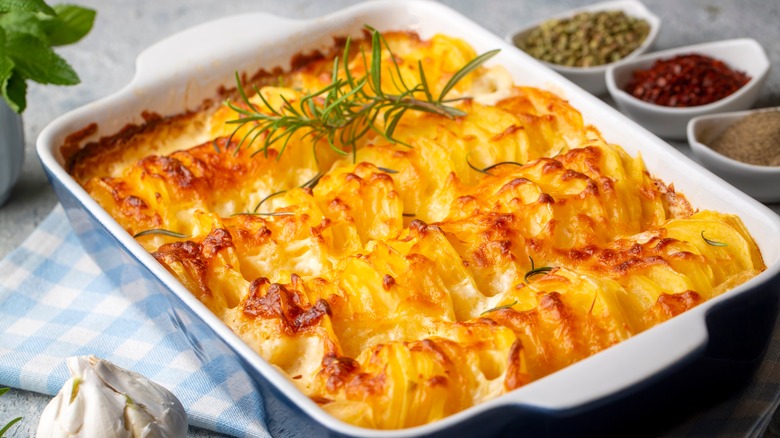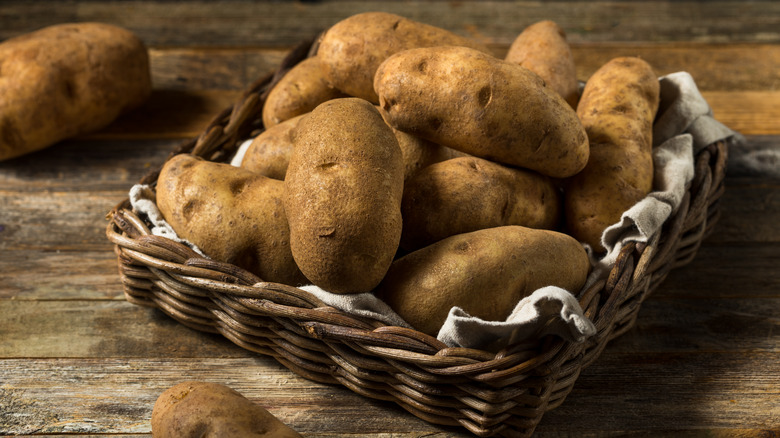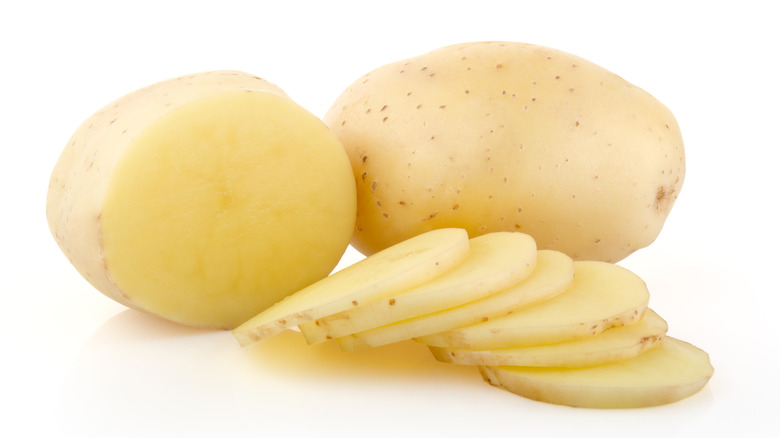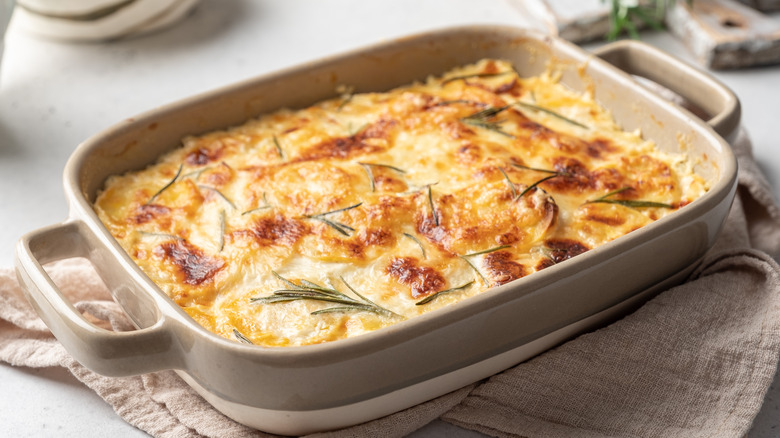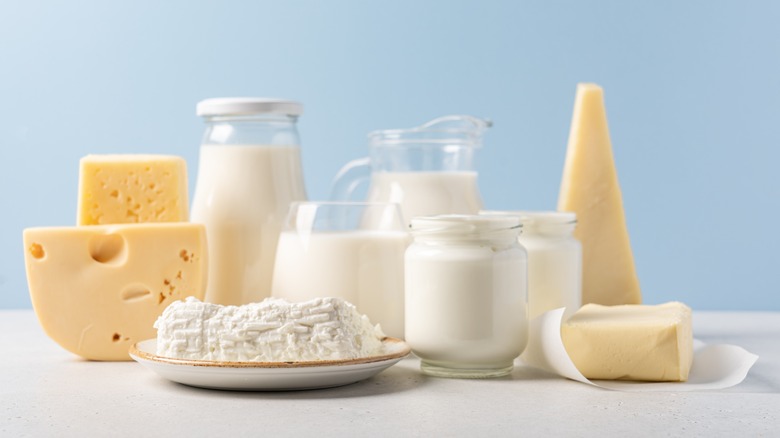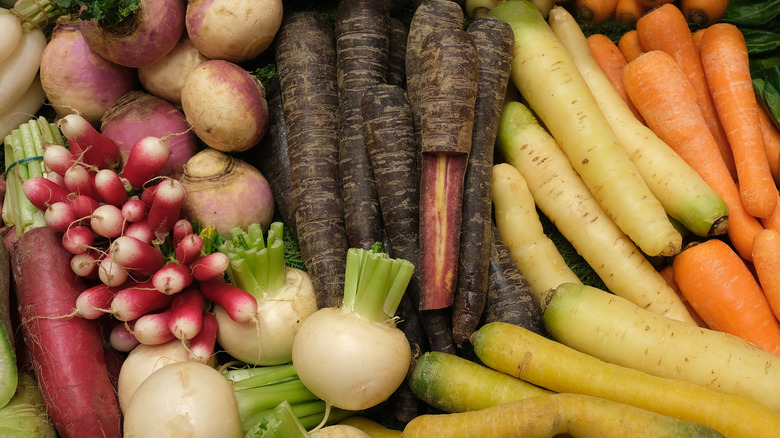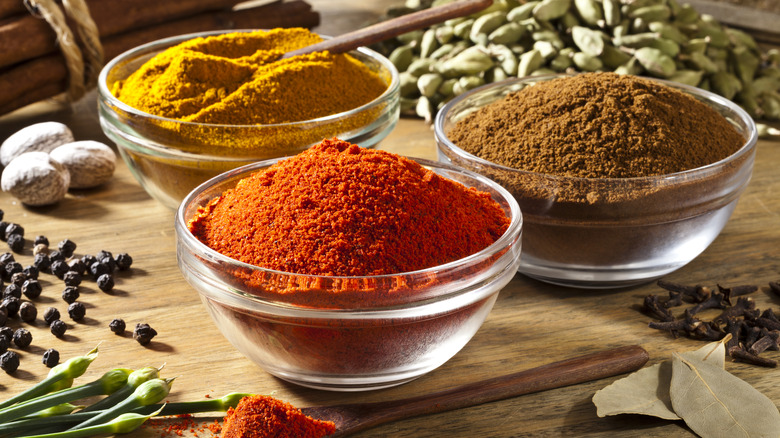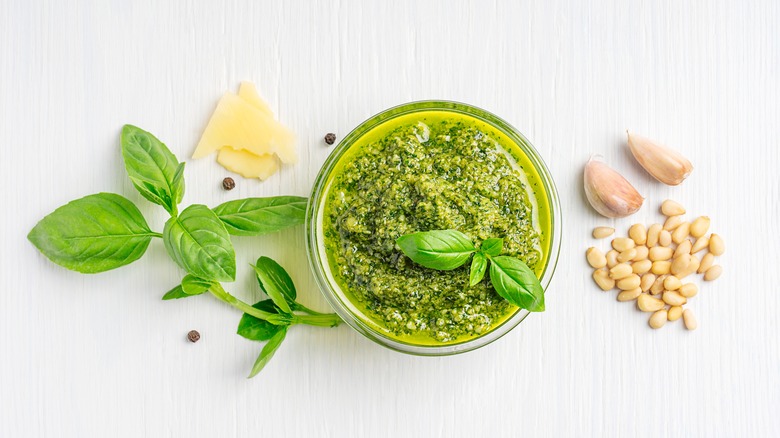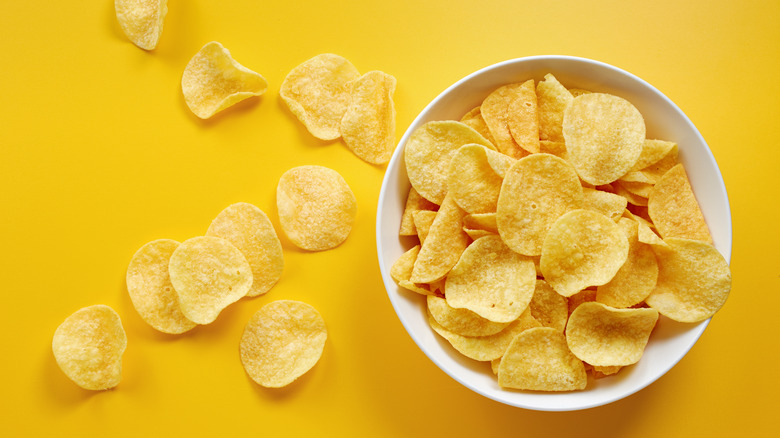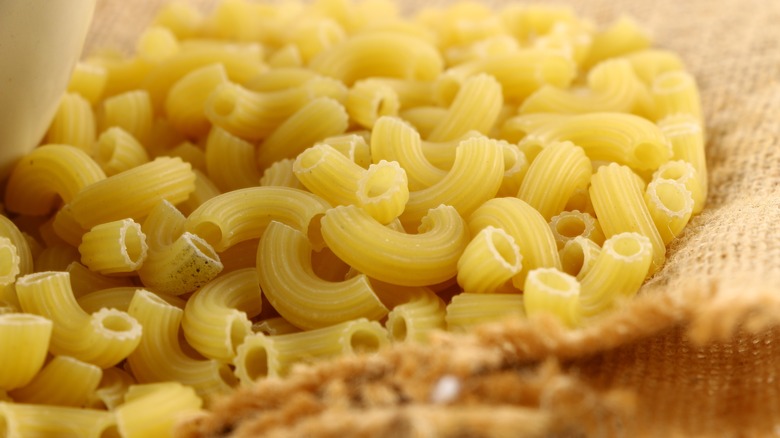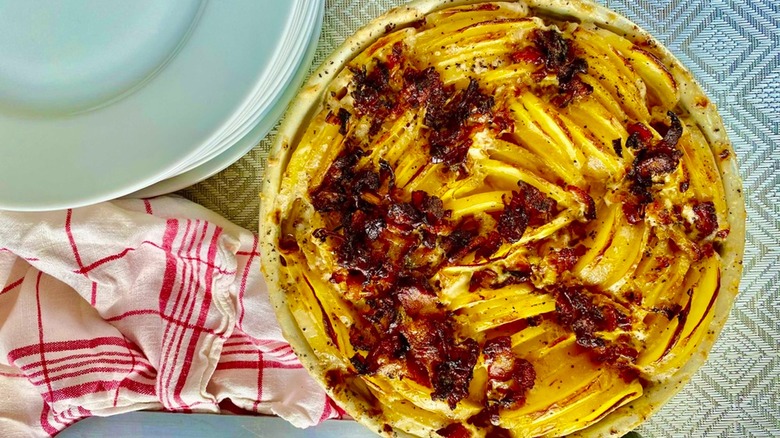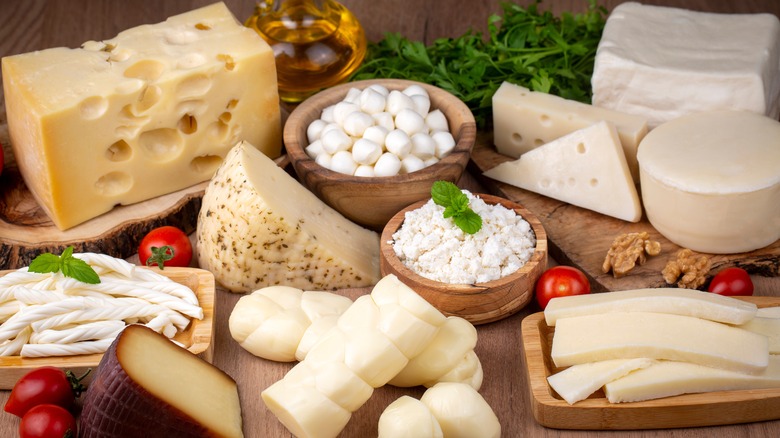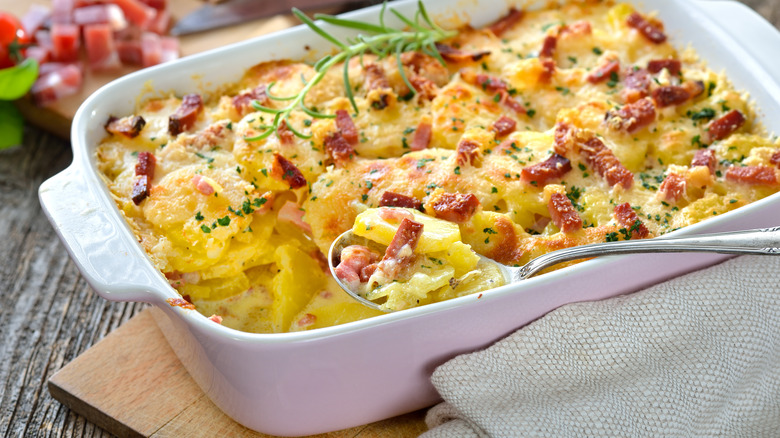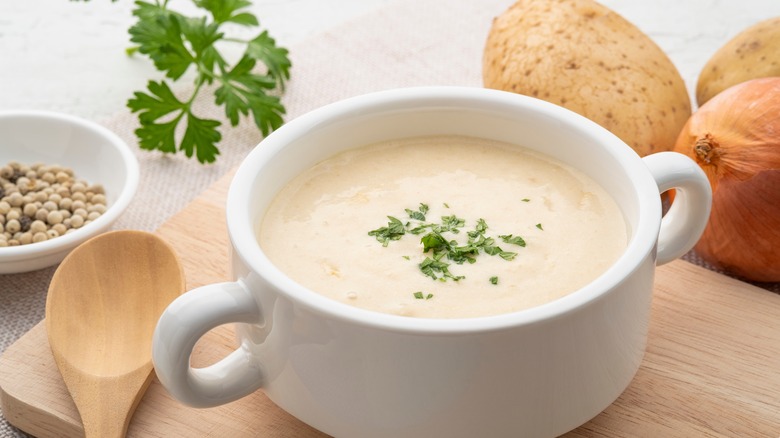15 Tricks That Will Seriously Upgrade Your Scalloped Potatoes
If your scalloped potatoes are missing that all-important "wow" factor or ending up less than great, you can easily upgrade them with just a few easy tricks. There's no need to make another dish of scalloped potatoes that comes out undone, curdled, or bland. Just making a few tweaks here or there can improve your culinary game and elevate the flavor of the casserole from ordinary to extraordinary. We've uncovered a variety of tricks, ideas, and add-ins that will help you create a masterpiece of taste and texture.
The ingredients matter, so you'll want to start with the right potatoes and dairy products to get the results you crave. There are even substitutions to use if you don't have any dairy products available. From add-ins and toppings to cooking methods, you'll soon be armed with a whole list of ideas that can positively change your scalloped potatoes for the better.
1. Start with the right potatoes
When you think about making scalloped potatoes, you shouldn't just reach into the pantry and pull out just any potato and think you'll get the same results. There are over 200 types of potatoes you can find in grocery stores in the U.S. However, not all of them are equal when it comes to specific potato dishes. For the best scalloped potatoes, you'll want to start with starchy potatoes, which add creamy depth to the sauce.
Russet potatoes and Idaho potatoes are the most common starchy potatoes you'll find at the grocery store. They are quite popular for making french fries and baked potatoes, so you may already have some at home.
It's not impossible to use waxy potatoes like red potatoes for the casserole. However, they won't act as a thickening agent for the sauce. Plus, they don't tend to soften as much when baked and may require partial boiling beforehand, which adds extra steps to the cooking process.
2. Ensure your potatoes are the right thickness
Scalloped potatoes are cut into rounds, similar in shape to potato chips. You want these rounds to be between ⅛ and ¼ an inch thick. Keeping them extremely thin helps to cook them through quickly. Thinner potatoes also absorb more flavor. Plus, thinly sliced potatoes collectively have more overall surface area for optimum flavor exposure.
We strongly suggest that you also cut them to equal thicknesses. If some pieces are twice as thick as others, they won't be uniformly done. Plus, the textural experience will be different if some slices are different sizes. It's possible to cut them into uniform slices by hand, using your fingers as a thickness guide and being careful to hold the knife straight for even, vertical cuts. Alternatively, you can use a precision slicing machine like a mandoline or a food processor with a slicing attachment to help you cut uniform slices.
3. Keep your sauce thick
If your sauce is runny, you end up with a dish that's more like potato soup than scalloped potatoes. The first trick to keeping your sauce thick is to refrain from soaking or rinsing your potatoes. You want all that starchy goodness to end up in your sauce and not poured down the drain. When you add liquid to your dish, it should even out with the top layer of ingredients. If you add liquid past the ingredient line, you're likely to get a final product that's swimming in sauce.
If you take the dish out of the oven and it still looks runny, don't despair. Let your potatoes sit out at room temperature for 20 or 30 minutes to cool down the ingredients and for the sauce to thicken. If you've gotten to the end of the cooking time and resting time and that the sauce is still runny, you can still salvage it. The easiest thing to do is to introduce instant potato flakes into the sauce. This way, you're not diluting the flavor with a bland thickener because the flakes already taste like potatoes.
4. Go full fat (but not acidic)
Using full-fat dairy products for scalloped potatoes contributes to the dish's texture, flavor, and overall appeal. You'll find that using low-fat dairy products can lead to a curdled sauce. The lower the fat content in the dairy product, the more likely the proteins will break apart and curdle when heated. So, you'll want to choose half-and-half or heavy cream when adding liquids to the sauce. Even whole-fat milk can be problematic. Plus, the overall flavor will be fuller and richer because fat helps concentrate all the other flavors in the dish. Your tastebuds will thank you for using full-fat dairy products.
One mistake people make when adding creamy, fatty ingredients to this casserole is using acidic dairy products like sour cream, buttermilk, or yogurt. They sound like they would be amazing additions to give the dish a touch of sourness, especially when paired with green onions or ranch seasoning. However, introducing acidic ingredients will likely curdle your sauce and prevent your potatoes from cooking through, even if you cook them longer.
5. Add other root veggies
If you've never tried mixing in other root veggies when making scalloped potatoes, you're missing a treat. You can easily follow your favorite scalloped potatoes recipe and substitute other root veggies for some of the potatoes. There are several options, including carrots, parsnips, turnip roots, celery roots, beets, and sweet potatoes. Even if you assume you don't like a particular root vegetable, you might find that you like it when roasted and covered with a creamy sauce, cheese, garlic, and spices.
You'll want to slice the other root veggies to the same thickness as your potatoes. While you can mix the sliced veggies throughout the dish, scalloped root veggies are even more striking when arranged in rows by type. You could create a whole rainbow of colors with alternating rows of purple beets next to yellow potatoes, orange sweet potatoes, and white parsnips.
6. Make it international
If you've been eating ordinary scalloped potatoes for years and would like a different flavor profile for the dish, consider going for an international theme. You can draw inspiration from a variety of flavor traditions, including Mexican, Indian, Greek, and even Chinese.
You can give your casserole a Mexican flair with the addition of ingredients like canned green chiles and pepper jack cheese, taco seasoning and Mexican canned corn, or salsa and queso. Indian scalloped potatoes could include ingredients like garlic, onions, hot peppers, coriander, cumin, turmeric, chili powder, cardamom, garam masala, and tomato paste. Or you could make a simpler version with just garlic, green onions, and garam masala as the main flavor notes. Greek scalloped potatoes would contain ingredients like oregano, lemon juice, parsley, and feta cheese. If you want to go in a more Chinese direction, omit all the dairy and use a sauce made of soy sauce, rice vinegar, and sugar instead. Other flavors could come from red pepper flakes, garlic, green onions, and chili peppers.
7. Add flavor-boosting ingredients
While cream and cheese go nicely with this dish, potatoes and dairy products have mild flavors, so you want to add ingredients to your scalloped potatoes that have more intensity.
Alliums are especially good flavor sources for this dish, so think in terms of adding ingredients like chopped green onions, caramelized onions, fresh garlic, and French-fried onions. Some cooks go as far as to rub the casserole dish with a cut clove of garlic before oiling or buttering it and adding the other ingredients. A can of chopped peppers can add flavor and even heat to the dish if you choose a spicy variety of peppers. Another option is to stir in a jar of pesto, which will permeate the dish with its rich basil flavor. Mushrooms also make an interesting addition, and you can even use truffle oil to enhance the flavor.
We also like the idea of adding ranch seasoning to the sauce since it has so many ingredients that taste good with potatoes. However, since ranch dressing mix has acidic ingredients like buttermilk and lactic acid, it might be a good idea to start with pre-cooked potatoes. Just keep in mind that the seasoning mix may cause the sauce to curdle.
8. Keep the temperature low
Keeping the temperature low for your scalloped potatoes is essential to create the best texture. We've already mentioned several things that can make the dairy products in your dish curdle, like using low-fat dairy products or acids. However, even if you do everything else right, high heat can still cause the proteins in your dairy products to separate, leaving you with a curdled sauce.
You will want to keep the temperature around 350 degrees Fahrenheit to activate the Maillard reaction so that you end up with a browned top to your dish. Yes, it will take a couple of hours for your potatoes to soften and the sauce to thicken at this temperature. However, you'll appreciate the end results.
Adding foil is a great trick that allows the ingredients to steam and soften while cooking at low temperatures. However, you will want to remove the foil during the final 15 minutes so the top can start to brown.
9. Give it a crunchy topping
A textural contrast between soft, cooked potatoes and a crunchy topping can upgrade your dish. While we have several options in mind, you can also look in your cupboard for crispy snack foods that you can crumble to add on top.
One of the most obvious options is potato chips. Plain chips work just fine; however, you can take the topping to the next level with flavored chips such as salt and vinegar chips or sour cream and onion chips. We can't think of too many flavors that wouldn't make for a more interesting casserole.
Another option is to top the dish with French-fried onions. Not only will it add crunch, but it also adds a more intense onion flavor to the casserole. Ritz crackers are another option. You can even use crushed cornflakes. The cornflake trick comes from funeral potatoes but easily translates to the scalloped variety.
10. Add macaroni
When you're putting together a casserole dish full of scalloped potatoes, it's easy to see some similarities to another cheesy dish — macaroni and cheese. Why not combine the two into a superior dish full of carby, cheesy goodness?
The good news is that all the starches from the potatoes help thicken the sauce so that you don't have to start out with a mornay sauce. Other than substituting just-cooked elbow macaroni pasta for some of the potatoes in the recipe, you can follow the same recipe for making the dish that you normally would. However, you will want to pre-cook the potatoes before putting the ingredients together because if you cook the pasta for as long as you'd normally cook scalloped potatoes that start raw, you end up with mush instead of macaroni. Instead, only cook the pasta for about 20 minutes, which is long enough for the noodles to get softer and the sauce to thicken.
11. Make it meaty
A great trick to upgrade your scalloped potatoes is to add meat. Adding meat takes it from a vegetarian side dish to a full meal. Just about any meat will do, but we have some favorites.
We like the idea of adding crumbled breakfast sausage, which pairs well with cheddar cheese and could, in a vague way, remind you of breakfast. Sliced smoked sausage tastes good with the dish, as well. You can choose from a mild or spicy sausage depending on your flavor preferences — just be sure to remove any casings to make the casserole easier to eat. Pepperonis make an interesting addition, which may inspire you to add herbs like oregano and basil. You can even treat the whole dish like a pizza by adding pizza sauce and placing pepperonis and mozzarella cheese on top.
Diced ham or fried bacon are also tasty add-ins. The salty flavor of these meats pair well with the cheese and potatoes — you could also use leftover holiday ham or cooked chicken. Using pre-cooked meat from a rotisserie chicken from the grocery store can help save time.
12. Consider alternative cheeses
Scalloped potatoes in their purest form don't contain cheese. In fact, the difference between scalloped potatoes and potatoes au gratin is that the au gratin version comes with cheese. However, modern cooks have started using the names of the dishes interchangeably, and you'll find plenty of recipes that include cheese. Honestly, there's no reason you have to stay within the confines of your recipe when it comes to adding different types of cheese to the casserole.
You'll want to choose cheeses that melt easily rather than cheeses that tend to keep their shape. All types of cheddar are lovely, but you can also go with Gruyère, Gouda, Fontina, or Monterey Jack. Velveeta is even a possibility, as it creates an indulgently creamy cheese sauce. There's also no rule saying you have to choose just one cheese. You could start with something mild and add a little bit of sharper cheese like asiago for added character. For something completely different, you could even try goat cheese or blue cheese if you choose the right herbs to accompany them.
13. Turn it into breakfast
Scalloped potatoes aren't just appropriate as a side dish or a main course for lunch or supper. It's also a creative option for breakfast. After all, it includes ingredients like potatoes and cheese that you already see in breakfast dishes all the time. So, what's stopping you from taking it all the way?
The easiest way to turn this casserole into a breakfast casserole is to add breakfast meats. You can add cooked bacon, breakfast sausage, or ham to easily turn any recipe into one fit for breakfast. You can also add a mixture of eggs and milk and cover it with breakfast meat and shredded cheese during the last 30 minutes or so of cooking.
For a non-meat alternative, you can use omelet ingredients to inspire you like red bell peppers, grilled onions, or mushrooms. No matter whether you're looking for meat or vegetable add-ins, you can let the ingredients you like most in breakfast dishes give you an idea of what to add to this potato and egg dish.
14. Serve it loaded
Baked potatoes and french fries aren't the only types of potatoes you can eat loaded. Scalloped potatoes also deserve the royal treatment with lots of tasty ingredients either cooked in or added after cooking is complete.
The most basic version of loaded scalloped potatoes comes with ingredients like cheddar cheese, cooked bacon, and green onions (or chives) baked into the casserole. However, you can add as many toppings as you like. For example, after the dish is done, you could add more proteins like cheese, pulled pork, or black beans. Sauces like ranch dressing or sour cream can add an extra layer of flavor. Plus, you have the opportunity to add vegetables like corn kernels, roasted peppers, or jalapeños. The time after the casserole emerges from the oven is also a great opportunity to throw on some fresh herbs like dill, parsley, or cilantro, or kick it up a notch with bagel seasoning, taco seasoning, or Cajun seasoning.
15. Add creamy soups
If you don't want to run to the store for some heavy cream but have creamy soups in your cupboard, they are more than adequate to use as the cream base to upgrade your scalloped potatoes. You can use cream of mushroom, cream of chicken, or cream of celery soup. You could even go for something like cream of bacon or cream of cremini and shiitake mushroom soup. And if you want more potatoes in your potatoes, you could even add cream of potato soup. Just keep in mind that choosing any of these will alter the overall flavor elements of your casserole. So, you might want to think about adding spices that will help to create the overall taste traits that you hope to convey.
To substitute creamy soups in for dairy products, you'll probably have to expand the volume of your soup to match the recommended amount of dairy. To do this, you can mix the soup with regular milk, water, or even broth, depending on what liquids you have available.
